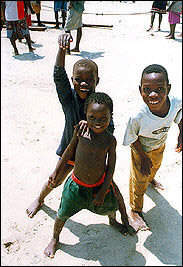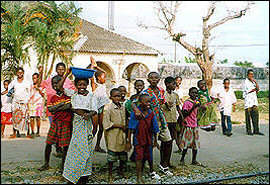 Statistical survey Statistical survey |
 AREA, POPULATION AND DENSITY AREA, POPULATION AND DENSITY |
| Area (sq. A Area (sq. km) 322,462 | | Population (census results) | | 30 April 1975 6,702,866 | | 1 March 1988 | | Males 5,527,343 | | Females 5,288,351 | | Total 10,815,694 | | Population (official estimates at mid-year) | | 1993 13,175,000 | | 1994 13,695,000 | | Density (per sq. km) at mid-1994 42,5 |
* 124.503 sq. miles.
 POPULATION BY ETHNIC GROUP (1988 census) POPULATION BY ETHNIC GROUP (1988 census) |

| Ethnic group Number % | | Akan 3,251,227 30,1 | | Voltaic 1,266,235 11,7 | | Mane Nord 1,236,129 11,4 | | Krou 1,136,291 10,5 | | Mane Sud 831,840 7,7 | | Naturalized Ivorians 51,146 0,5 | | Others 3,039,035 28,1 | | Unknown 3,791 0,0 | | Total 10,815,694 100,0 |
Source:UN, Demographic Yearbook.
 POPULATION BY REGION (1988 census) POPULATION BY REGION (1988 census) |

| Region Population | | Center 815,664 | | East Center 300,407 | | North Center 915,269 | | West Center 1,542,945 | | North 745,816 | | North-East 514,134 | | North-West 522,247 | | West 968,267 | | South 3,843,249 | | South-West 647,696 | | Total 10,815,694 |
Source: UN, Demographic Yearbook
PHOTO 12
 PRINCIPAL TOWNS (population at 1988 census) PRINCIPAL TOWNS (population at 1988 census) |
Abidjan* . . . . 1,929,079 Korhogo . . . . 109,445
Bouaké . . . . 329,850 Yamoussoukro* . 106,786
Daloa . . . . 121,842
* The process of transferring the official capital from. Abidjan to Yamoussoukro began in 1983
Source: UN, Demographic Yearbook. |  BIRTHS AND DEATHS (UN estimates, annual averages) BIRTHS AND DEATHS (UN estimates, annual averages) |
| 1980-85 1985-90 1990-95 | | Birth rate (per 1,000) 50,2 49,9 49,9 | | Death rate (per 1,000) 15,8 14,8 15,1 |
Expectation of life (UN estimates, years at birth, 1990-95): 51.0(males 49.7; females 52.4).
Source: UN,World Population Prospects: The 1994 Revision.
 ECONOMICALLY ACTIVE POPULATION ECONOMICALLY ACTIVE POPULATION |
| Males Females Total | | Agriculture, etc 1,911 975 2,886 | | Industry 430 220 650 | | Services 1,398 714 2,112 | | Total 3,739 1,909 5,648 |
Source: UN Economic Commission for Africa. African Statistical Yearbook.
 Agriculture Agriculture |
PHOTO 13
PRINCIPAL CROPS ('000 meter tons)
| 1992 1993 1994 | | Maize 538 529 536 | | Millet 51 80 81 | | Sorghum 28 31 31 | | Rice(paddy) 714 890 701 | | Sweet potatoes 36 36 36 | | Cassava(Manioc) 1,585 1,535 1,564 | | Yams 2,910 2,850 2,824 | | Taro(Coco yam) 337 315 337 | | Pulses 8 8 8 | | Tree nuts 15 15 15 | | Sugar cane 1,600 1,450 1,469 | | Palm kernels 41.1 34.5 31.9 | | Groundnuts(in shell) 140 151 137 | | Cottonseed 100 124 133 | | Coconuts 237 225 213 | | Copra 39 36 36 | | Tomatoes 40 40 43 | | Aubergines(eggplants) 40 40 41 | | Green peppers 23 23 23 | | Other vegetables 363 343 343 | | Oranges 28 28 28 | | Other citrus fruit 28 28 28 | | Bananas 191 192 199 | | Plantains 1,281 1,300 1,300 | | Mangoes 14 14 14 | | Pineapples 201 198 206 | | Other fruit 12 13 13 | | Coffee(green) 125 139 148 | | Cocoa beans 697 804 809 | | Tobacco(leaves) 10 10 10 | | Cotton(lint) 87 111 116 | | Natural rubber(dry weight) 72 90 97 |
* FAO estimate(s).
+ Unofficial figure.
Source: FAO, Production Yearbook.
 LIVESTOCK ('000 head, year ending September) LIVESTOCK ('000 head, year ending September) |
| 1992 1993 1994 | | Cattle 1,180 1,205 1,232 | | Pigs 382 392 404 | | Sheep 1,190 1,219 1,251 | | Goats 931 954 976 |
Poultry (million): 25 in 1992; 26 in 1993; 27 in 1994.
Source: FAO, Production Yearbook. |

